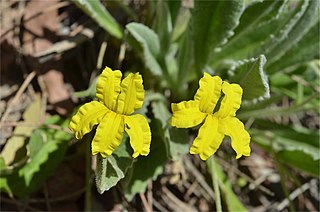Goodenia bicolor is a species of flowering plant in the family Goodeniaceae and is endemic to north-western Australia. It is an annual or ephemeral herb with lance-shaped to egg-shaped leaves with the narrower end towards the base, racemes of yellow or yellow and purple flowers and elliptical fruit.
Goodenia brachypoda is a species of flowering plant in the family Goodeniaceae and is endemic to northern Australia. It is a low-lying to upright herb with narrow elliptic to oblong leaves, racemes of yellow flowers with leaf-like bracts at the base, and more or less spherical fruit.
Goodenia centralis is a species of flowering plant in the family Goodeniaceae and is endemic to central Australia. It is a prostrate, annual herb with coarsely toothed, spatula-shaped to egg-shaped leaves with the narrower end towards the base, and racemes of yellow flowers with purple veins.
Goodenia drummondii is a species of flowering plant in the family Goodeniaceae and is endemic to the south-west of Western Australia. It is an erect shrub with linear to lance-shaped stem leaves, and spike-like thyrses of small white flowers with purplish spots.
Goodenia durackiana is a species of flowering plant in the family Goodeniaceae and is endemic to north-western Australia. It is an erect to low-lying herb with elliptic to oblong stem leaves with coarse teeth on the edges, and racemes of yellow flowers.

Goodenia gibbosa is a species of flowering plant in the family Goodeniaceae and is endemic to central Australia. It is a prostrate to low-lying, often stoloniferous herb covered with soft hairs. It has elliptic to lance-shaped leaves and small groups of yellow flowers.
Goodenia glandulosa is a species of flowering plant in the family Goodeniaceae and is endemic to dry, inland areas of Australia. It is an erect, perennial herb with linear to lance-shaped leaves and racemes of yellow flowers.
Goodenia gloeophylla is a species of flowering plant in the family Goodeniaceae and is endemic to northern Australia. It is an erect, slightly woody under-shrub with linear to narrow elliptic, toothed or narrowly-lobed leaves, and racemes of pale to deep purple flowers.
Goodenia janamba is a species of flowering plant in the family Goodeniaceae and is endemic to northern Australia. It is an erect herb with linear to lance-shaped leaves mostly at the base of the plant, and umbels or racemes of flowers that are yellow, or purplish with a yellow centre.
Goodenia laevis, commonly known as smooth goodenia, is a species of flowering plant in the family Goodeniaceae and is endemic to south-western Western Australia. It is a prostrate or ascending sub-shrub with oblong to lance-shaped leaves with the narrower end towards the base and racemes or thyrses of yellow flowers with purplish markings.
Goodenia leptoclada, commonly known as thin-stemmed goodenia, is a species of flowering plant in the family Goodeniaceae and is endemic to the extreme south-west of Western Australia. It is an ascending perennial herb with lance-shaped to egg-shaped leaves with the narrower end towards the base and racemes of blue flowers.
Goodenia malvina is a species of flowering plant in the family Goodeniaceae and is endemic to north-western Australia. It is a prostrate to low-lying herb with egg-shaped to lance-shaped leaves on the stems and racemes of mauve to pinkish and yellowish flowers.

Goodenia racemosa is a species of flowering plant in the family Goodeniaceae and is endemic to Queensland. It is an erect undershrub with linear or narrow oblong leaves and racemes of vivid yellow flowers.
Goodenia redacta is a species of flowering plant in the family Goodeniaceae and is endemic to northern Australia. It is a prostrate to low-lying herb with toothed, egg-shaped leaves at the base of the plant, and racemes of yellow flowers with a brownish centre.

Goodenia robusta, commonly known as woolly goodenia, is a species of flowering plant in the family Goodeniaceae and is endemic to southern Australia. It is an erect or ascending perennial herb with crowded, hairy, elliptic to narrow oblong leaves at the base of the plant, and racemes of yellow flowers.
Goodenia schwerinensis is a species of flowering plant in the family Goodeniaceae and is endemic to inland areas of Western Australia. It is a prostrate to low-lying herb with elliptic to lance-shaped leaves with toothed or lyrate edges, and racemes of yellow flowers.

Goodenia triodiophila, commonly known as spinifex goodenia in the Northern Territory, is a species of flowering plant in the family Goodeniaceae and is endemic to arid inland areas of Central Australia. It is a stiff, wiry, much-branched, ascending perennial herb with needle-shaped or linear leaves on the stems and racemes of yellow flowers with a brownish centre.
Goodenia virgata is a species of flowering plant in the family Goodeniaceae and is endemic to the Tanami Desert in central Australia. It is an erect to ascending herb with more or less thick, linear to lance-shaped leaves with the narrower end towards the base, and racemes of yellow flowers.

Goodenia watsonii is a species of flowering plant in the family Goodeniaceae and is endemic to the south-west of Western Australia. It is a perennial herb with egg-shaped to elliptic leaves mostly at the base of the plant, and thyrses of white, cream-coloured or bluish flowers.
Goodenia wilunensis is a species of flowering plant in the family Goodeniaceae and is endemic to central regions of Western Australia. It is an ascending to prostrate annual herb covered with silky hairs and has elliptic to egg-shaped leaves with the narrower end towards the base, and racemes of yellow flowers with purplish markings.





